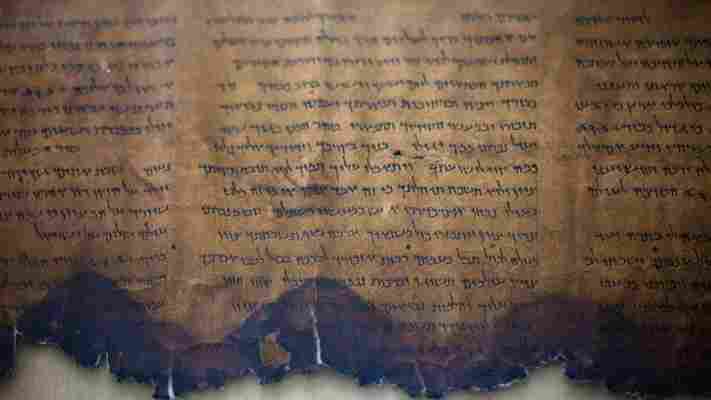Article continues below
“Is that what you’re wearing?” the security guard asked as I stood at the entrance to the giant Wadi Mujib gorge in southern Jordan.
I was dressed in what my brother refers to as my ‘journalist costume’: long-sleeve khaki shirt, green army trousers and boots – a fashion-backward ensemble meant to protect me from the pounding summer sun.
“Yes?” I replied tentatively. The guard smirked and waved me through.

The author began his journey to unravel a century-old mystery in Jordan’s Wadi Mujib (Credit: LOOK Die Bildagentur der Fotografen GmbH/Alamy)
You may also be interested in: • The Israeli city with a hoard of gold • The lost jewels of Bad King John • An epic search for Russia’s lost gold
Sheer rust-tinted cliffs climbed more than 30m on either side of me, and a channel of deep green water trickled out toward the Dead Sea. The more I walked, the deeper it became, and soon I was in water up to the collar of my very inappropriate shirt. I looked over at my driver, who had joined me on what was now, clearly, an ill-advised outing. He was luxuriating in his boxer shorts.
“Flood,” he said.
Then he dived under the water.
We hiked this way for the better part of two hours, scaling rocks and dodging waterfalls in the flooded passageway until the current became too rough and we had to turn back.
***
My visit to Wadi Mujib (believed to be what was known in the Bible as Arnon ) was the first step in my journey to solve a century-old mystery.
That story began in 1883, when Moses Wilhelm Shapira, an antiquities dealer from Jerusalem, showed up on the doorstep of London’s British Museum claiming to have in his possession the oldest biblical manuscript in the world, a set of scrolls inscribed with the Book of Deuteronomy, the fifth and final of the Five Books of Moses, which together with Prophets and Writings comprise the Old Testament. He claimed the manuscript had been discovered by nomadic Bedouin tribesmen in a cave overlooking Wadi Mujib. The text, Shapira noted, was remarkably different from that used in churches and synagogues, suggesting that the version believed to have been passed down from God to Moses had, in fact, been altered by human hands.
What’s more, Shapira wanted one million pounds for it – about £186 million in today’s money.

Shapira tried to sell his manuscript to the British Museum for one million pounds (Credit: Pawel Libera/Getty Images)
But there were those who doubted Shapira’s bold claim, including noted French archaeologist Charles Clermont-Ganneau, who had previously accused Shapira of peddling counterfeit artefacts. Before agreeing to purchase the scrolls, the British Museum hired Christian David Ginsburg, one of the great Bible scholars of the day, to authenticate the ancient manuscript. While Ginsburg toiled away in the museum, Shapira became an overnight celebrity as newspapers reported on his comings and goings in their literary gossip columns.
After four weeks, Ginsburg came out with a verdict: the manuscript was a fake. Shapira, he said, had taken a genuinely old Torah scroll, sliced off its blank lower margin, and inscribed that ancient-looking strip with his own version of Deuteronomy.
Distraught and humiliated, Shapira fled the UK. In March 1884, he gathered what money he had left, took a room in a seedy hotel in Rotterdam, and shot himself in the head.
The similarities were too striking to dismiss
For those following the affair, Shapira’s death at the age of 54 seemed to be the sad end of his story. But fast forward more than 60 years to the discovery of the Dead Sea Scrolls , thousands of ancient biblical scrolls and scroll fragments first uncovered in 1947. Shapira’s Deuteronomy was said to have been stashed away in a cave. So, too, were the Dead Sea Scrolls . Shapira’s manuscript was full of interesting departures from the traditional Bible text. So, too, were the Dead Sea Scrolls. Shapira’s text was found by Bedouin wandering the deserts near the Dead Sea. So, too, were the Dead Sea Scrolls.

Discovered more than 60 years later, the Dead Sea Scrolls bore a striking resemblance to Shapira’s manuscript (Credit: Uriel Sinai/Getty Images)
The similarities were too striking to dismiss. Beginning in the 1950s, a number of scholars decided to return to Shapira’s manuscript, using methods not available to Ginsburg in 1883, to prove once and for all whether it was real or fake.
But there was a problem: Shapira’s scrolls had mysteriously vanished.
***
My fascination with Shapira’s scrolls – which I had first learned about from my father, a Bible scholar – had proved too strong to resist. Several years ago, keen to begin researching a book I planned to write on the manuscript, I had travelled to Jordan after a week in Israel, where I was supposed to be working on an article about Arab soldiers who serve in Israel’s army.
Instead, I spent much of my time in Jerusalem’s Old City on Shapira’s trail. I began at Christ Church, where Shapira was married, baptized his two daughters, and was known to read his Bible during the pastor’s Sunday sermon. From there I walked down the cobblestones of Armenian Quarter Street and hung a right onto King David Street, descending the broad steps to Christian Street, where Shapira once had his antiquities shop. Apart from the T-shirts hanging outside a souvenir stall the street looked much as it would have when Shapira worked there.
Shapira married his wife and baptized his two daughters in Jerusalem’s Christ Church (Credit: Reynold Mainse/Design Pics/Getty Images)
While my visit allowed me to envision Shapira’s Jerusalem, I uncovered no clues as to the whereabouts of his missing scrolls. This was not surprising – after all, they had disappeared in London.
So I booked a ticket to the UK.
***
The British Library sits across from London’s King’s Cross/St Pancras Station, but while the train depot was teeming, the library was muted. Researchers sat silently at wooden desks, carefully reading through illuminated manuscripts, antique letters and musical scores. I had come to pore over the dozens of authentic Torah scrolls also purchased from Shapira before that fateful summer of 1883, along with a dossier holding correspondence relating to the Shapira affair.
Although the famous missing manuscript was nowhere to be found among the 150 million items in the library’s astounding collection, I did uncover a handwritten note from the museum’s chief librarian in 1883 noting that after Shapira died, his widow, Rosette, had sent two small fragments of the scrolls to a German scholar. If I could track these fragments down, I realised, I could discover the truth about Shapira’s manuscript.
So I booked a flight to Germany.
***
The town of Schlitz in central Germany is named for its river, but is better known for the romantic castles that infuse its Old Town with a quaint vibe. Craftsmen at Germany’s oldest distillery produce schnapps and whisky – bottled courage for a winter’s day as cold as the one I chose to visit Annette Schwarz-Scheuls, a distant cousin of Shapira’s late wife.
The author travelled to Schlitz, Germany, to visit a distant cousin of Shapira’s late wife (Credit: H Leue/LOOK-foto/Getty Images)
“I can’t be neutral,” Schwarz-Scheuls told me as we warmed up over coffee and pastries in her kitchen. The 52-year-old woman had already told me she didn’t have the scrolls, so I’d moved on to asking if they’d really been fakes. “I’m on the side of the family. It’s only a personal opinion, a very personal opinion, that he is [a] ‘master forger’. It is not [true] in my eyes. You understand this?”
I did understand. Although I hadn’t found the manuscript fragments, I had also failed to uncover anything that suggested the scrolls were forgeries. Indeed, after more than three years of searching I was becoming increasingly convinced that they had been real. More than a century after his death, Shapira’s family agreed.
But my search was going nowhere. In Jordan and Israel, the UK and Germany, I had hit dead end after dead end.
After more than three years of searching I was becoming increasingly convinced that the scrolls had been real
Then one evening seated at my desk in San Francisco more than a year after leaving Germany, I received an email that blew my search wide open. It came from Matthew Hamilton, a biblical researcher living in the suburbs of Sydney, whom I had never met.
“Researching early biblical [manuscripts] over the past 25+ years … I’ve always been aware of the Shapira [manuscript],” Hamilton wrote. “In late 2011 I was fortunate to find a reference showing who actually purchased the [manuscript].”
I wrote back immediately, but after a brief exchange during which he did not divulge the name of the buyer, Hamilton fell silent. For the next eight months I tried desperately to contact him, but he simply would not respond.
So I bought a plane ticket to Australia.
***
Early on a Sunday morning in May 2014, I landed in Sydney and caught a taxi to the quiet suburb of Tregear, where a private investigator I’d hired several months earlier told me Hamilton once lived. I stopped into a nearby church in hopes that someone from the community would know where to find him. I was in luck: Paul Beringer, the church’s former pastor, was an acquaintance.
However, Beringer then told me, “I haven’t seen him in 20 years.” But just as my hopes began to fall, he touched his chin and considered. “Come on, my car’s right across the road.”
And so Beringer and I began a tour of greater Sydney in his maroon Nissan to try to locate Hamilton. I knew that things were supposed to be different here – I’d heard toilets swirled counterclockwise Down Under – but everything I had seen thus far could as easily have been found in a suburb of my childhood hometown of Philadelphia. The area felt charming and familiar: cosy, single-level homes with neat lawns sat behind narrow pavements, and a large park framed Tregear’s western border.
The author flew to Sydney, Australia, to find Matthew Hamilton, who held a key to the mystery (Credit: Sean Caffrey/Getty Images)
Beringer parked and knocked at the front door of a modest house. A long moment later Hamilton emerged.
He was taller than I am, about 6ft. He looked about 35, though in fact he was 51. He had thick brown hair with patches of white at the temples and a thin mustache. After I introduced myself, Hamilton waved me in as if he had expected I’d turn up sooner or later.
Not long after inviting me inside, Hamilton drew a line in the sand. “I can talk about a lot of things relating to Shapira – but I can’t tell you the name,” he said.
Of course, the name was the entire reason I’d travelled all the way to Australia, and Hamilton’s stern warning made me feel like my trip was already a failure. But we chatted a little while longer and made a plan to meet for dinner the following evening.
The next night, Hamilton arrived at my hotel’s restaurant carrying two blue loose-leaf binders containing several years’ research on Shapira’s manuscript, significant portions of which had been blacked out.
“You’ll notice I redacted any mention of the name,” Hamilton said.
My plan involved buying him a few beers in hopes the drinks would dissolve his reluctance to reveal the name. But Hamilton didn’t drink beer, he told me.
Even so, something I did, or said, helped changed his mind: 3.5 hours after we sat down to eat, 36 hours after I’d landed in Australia, and about 5,832 hours after he had first sent me an email inquiring into my research, Hamilton simply blurted it out.
“Philip Brookes Mason,” he said.
***
In the late 19th Century, Mason was a physician and naturalist in the English Midlands and had purchased the Shapira manuscript sometime after it was put up for auction at Sotheby’s in 1885. Although he had been president of the Burton-on-Trent Natural History and Archaeological Society, Mason showed little obvious interest in Near Eastern history. Still, the famous Deuteronomy strips must have been alluring. In 1889, Mason displayed the manuscript before a small number of the society’s members. After that, no-one ever saw it in public again.
Philip Brookes Mason, a physician and naturalist in the English Midlands, had purchased the manuscript sometime after Shapira’s death (Credit: Chanan Tigay)
Armed now with the name, I booked a ticket to London and from there caught a train to Burton, where I took a room at The Three Queens Hotel , which more than a century ago had been Mason’s home. With its creaky staircases and quaintly sloping floors, the otherwise-renovated hotel betrayed its age. I searched the basement for any trace of the manuscript. When that turned up nothing, I pored over the accession records of every institution that purchased pieces of Mason’s collection after his death in 1903. But it led nowhere.
I returned home to San Francisco empty-handed and dejected. Five years in and my search had come to an end.
Almost.
***
Back in March 2012 I had received a tip from a rabbi in Cincinnati that more than 100 manuscripts once owned by Shapira resided in the collection of the late San Francisco mayor, Adolph Sutro. An avid book collector, Sutro had been in Jerusalem at the time of Shapira’s death and had scooped up his remaining manuscript stock. Today, by a bizarre coincidence, this little-known Shapira collection is held in the library building at San Francisco State University, where I am an assistant professor of creative writing.
When I first received the tip, the manuscripts were in transit to the university and so were inaccessible. Once they became available, the library’s very proximity had allowed me to put off visiting every time something else came up – a trip to Australia, for example. After returning home from the English Midlands, I realised that the Sutro collection was my last chance – the final corner left to search. If it held no new information, I had nowhere left to go.
So I continued to put off visiting.
Bible scholar Christian David Ginsburg believed Shapira had forged the manuscript using pieces of an old Torah scroll (Credit: Godong/Getty Images)
This inaction lasted months, until the impending deadline for my book forced me to face what could be the end of my search. I reluctantly made my way to the Sutro collection, where a librarian had already wheeled a number of carts full of material into a glass-walled room overlooking the university commons. Among the texts were centuries-old biblical manuscripts, Kabbalistic texts and even works of poetry.
About two hours into my search, I made a discovery that stopped me in my tracks. Inside a grey Velcro-sealed box was a well-preserved tome containing portions of the Old Testament books of Ezekiel and Jeremiah on bulky leather leaves. Flipping through the medieval codex, I reached a page on which the lower margin had been carefully sliced off.
Shapira might have been a forger, but it now seemed he was something else, too: a genius
Over the next day, I discovered five more codices in which margins had been removed – along with part of a Torah scroll containing 11 columns from the Book of Numbers. The entire lower margin, running to 45cm, was missing.
I thought of Ginsburg, who had suggested that the Jerusalem merchant had inscribed his falsified Deuteronomy on strips cut from the lower margins of a Torah scroll. Looking now at the deformed book before me, I began to wonder if he had been right after all.
I wanted to feel disappointed, but was surprised to find myself elated. Although I never located the scrolls, I found something else – if Shapira had manufactured the manuscript as the evidence now suggested, he had done so with such skill and expertise that, magically it now seemed, he had unknowingly foretold the existence of the Dead Sea Scrolls many decades before their discovery.
Shapira might have been a forger, but it now seemed he was something else, too: a genius.
Chanan Tigay is the author of The Lost Book of Moses: The Hunt for the World’s Oldest Bible , and a professor at San Francisco State University.
Join over three million BBC Travel fans by liking us on Facebook , or follow us on Twitter and Instagram .
If you liked this story, sign up for the weekly bbc.com features newsletter called "If You Only Read 6 Things This Week". A handpicked selection of stories from BBC Future, Earth, Culture, Capital and Travel, delivered to your inbox every Friday.

Leave a Reply